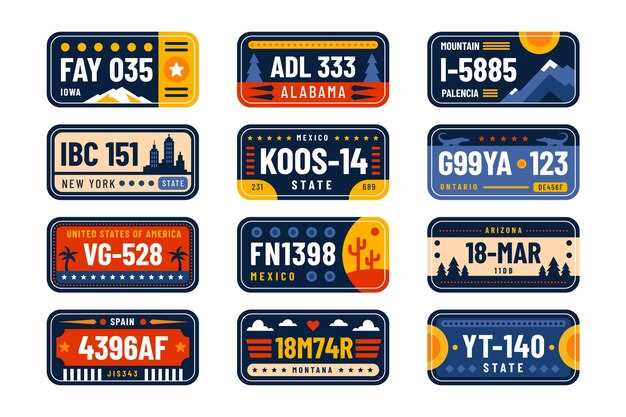
Vanity plates have become a fascinating facet of automotive culture in America, offering vehicle owners a unique opportunity to showcase their personality, beliefs, and humor through personalized license plates. From the first issuance of these plates in the early 1900s to the modern-day explosion of creative expressions, vanity plates reflect societal trends, individual identities, and an ever-evolving relationship with personal branding.
Initially, license plates served a purely functional purpose: to identify vehicles for registration and law enforcement. However, as the automobile became a symbol of freedom and individuality in the post-World War II era, vanity plates emerged as a way for drivers to express their distinctiveness. This cultural shift signified a move from mere identification to a canvas for self-expression, paving the way for the colorful and often humorous combinations of letters and numbers that we see today.
As the popularity of vanity plates grew, they began to intertwine with broader cultural movements, such as the rise of the custom car scene in the 1960s and 1970s. Today, these plates have transcended mere automotive adornments to become integral elements of personal identity, reflecting interests, professions, and social causes. Moreover, they have sparked debates about free speech, censorship, and the boundaries of public expression, showcasing their significance in American culture beyond just a form of personal decoration.
Historical Origins and Legal Framework of Vanity Plates

The concept of vanity plates, which are personalized license plates displaying unique combinations of letters and numbers, can be traced back to the early 20th century. The first recorded instance occurred in the late 1900s when automobile registrations began. As vehicles became more widespread, so did the desire for individuality among car owners.
Initially, license plates were issued by state governments and displayed random numbers or letters assigned to vehicles. In 1931, New York became the first state to allow motorists to apply for personalized license plates, introducing a system that enabled citizens to showcase their identities or interests through custom alphanumeric sequences.
Over time, other states adopted similar practices, recognizing the appeal and significance of vanity plates. By the 1970s, the concept had gained considerable traction, leading to a proliferation of personalized options across the nation. Enthusiasts enjoyed the ability to convey messages ranging from humor to personal aspirations, while others utilized these plates for promotional purposes or brand identity.
The legal framework surrounding vanity plates varies from state to state. Generally, prospective owners must submit their desired combination to the local Department of Motor Vehicles (DMV) or equivalent authority. Each state has guidelines to ensure combinations are not offensive, misleading, or deemed inappropriate. Many jurisdictions maintain a list of prohibited words or phrases, which are regularly updated to adhere to societal standards.
In some cases, states charge an additional fee for vanity plates, which contributes to funding specific programs or initiatives. Furthermore, registration and renewal processes frequently require owners to adhere to specified rules to maintain the legitimacy and uniqueness of their plates.
As vanity plates continue to evolve, they serve as a reflection of cultural trends and societal values, illustrating the ongoing relationship between personal expression and regulatory frameworks in American automotive culture.
Impact of Technology on Personalization of License Plates

The advent of technology has significantly transformed the landscape of personalized license plates in America. Innovations in digital design and printing have enabled individuals to create more intricate and unique combinations, pushing the boundaries of creativity. New software tools allow users to visualize their customizations in real-time, making it easier to choose and modify designs before finalizing an order.
Online platforms have centralized the process of obtaining vanity plates. State departments of motor vehicles have developed user-friendly websites where applicants can check the availability of specific combinations, submit requests, and make payments–all from the comfort of their homes. This has streamlined the application process, making it faster and more accessible.
Furthermore, the rise of social media has popularized personalized plates as a form of self-expression and identity. People share photos of their custom plates across various platforms, inspiring others to participate and fostering a sense of community around this form of personalization. Trends in popular culture and current events quickly influence the types of phrases and symbols chosen, as they spread rapidly through online interactions.
Advancements in technology have also led to the integration of smart technologies in vehicles, such as license plate recognition systems. This has shifted the focus from merely aesthetic personalization to considerations of functionality and security. In some regions, digital license plates that can be reprogrammed with varying designs or messages are emerging, allowing for an even more dynamic approach to personalization.
Overall, technology has expanded the possibilities for creative expression in the realm of vanity plates, making it more accessible and relevant to a broader audience, while continually evolving in response to cultural influences and technological advancements.
Cultural Significance and Trends in Vanity Plate Choices
Vanity plates have evolved into a unique expression of individuality and cultural identity within American society. They serve as a canvas for personal sentiments, social commentary, and humorous quips that reflect the owner’s personality or beliefs. The choice of plate letters, numbers, or combinations often showcases a deep connection to cultural trends, personal milestones, or popular phrases resonating with the broader public.
Cultural significance of vanity plates can be seen in their ability to convey messages that resonate beyond mere identification. They often encapsulate cultural movements, political statements, or even celebratory milestones such as anniversaries or achievements. For example, many plates feature references to popular culture, including movies, music, or significant events, which create a connection with a shared cultural lexicon. Such choices can transform a simple vehicle into a mobile billboard showcasing personal brand or values.
Moreover, trends in vanity plate selections can indicate shifting social norms and values. In recent years, there has been an increase in plates that promote inclusivity and diversity, often reflecting the evolving attitudes towards race, gender, and sexuality. Plates that embrace LGBTQ+ pride or advocate for social justice issues demonstrate a willingness to use personal vehicles as platforms for societal change. Such choices articulate not just individual identity but also align with larger cultural conversations.
The popularity of specific vanity plate themes can also vary over time. For instance, during economic downturns, plates that reference frugality or wit about the financial climate may become more prevalent. Conversely, during periods of growth, individuals might opt for plates that celebrate success and affluence. Additionally, the rise of technology and the internet has influenced vanity plate choices, leading to abbreviations and slang that reflect digital communication styles.
In essence, the evolution of vanity plates mirrors the complexities of American culture. They not only serve practical purposes but also offer insights into collective values, aspirations, and trends. Understanding these choices provides a richer perspective on how individuals navigate and contribute to the ever-changing cultural landscape.
